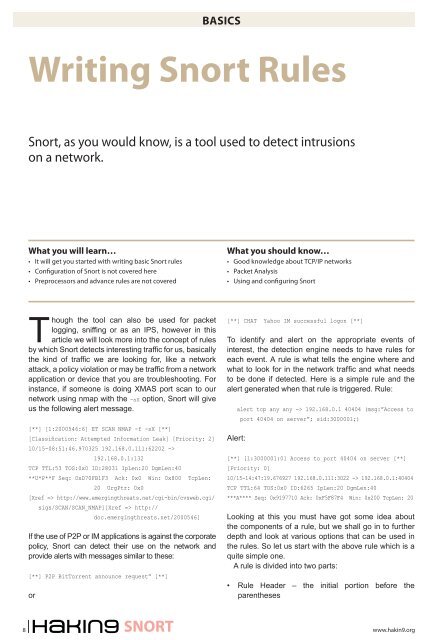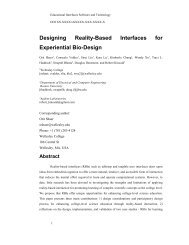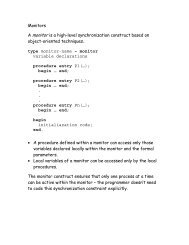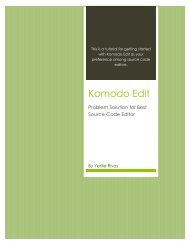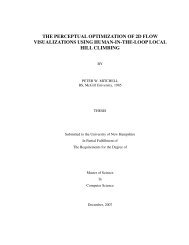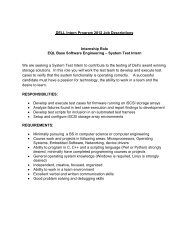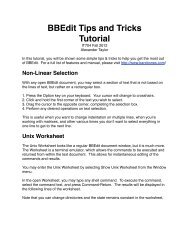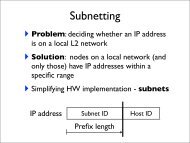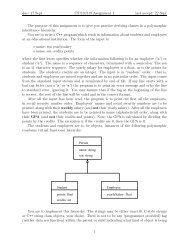SNORT Exposed Hakin9 StarterKit 01/2010 - Computer Science
SNORT Exposed Hakin9 StarterKit 01/2010 - Computer Science
SNORT Exposed Hakin9 StarterKit 01/2010 - Computer Science
Create successful ePaper yourself
Turn your PDF publications into a flip-book with our unique Google optimized e-Paper software.
BASICS<br />
Writing Snort Rules<br />
Snort, as you would know, is a tool used to detect intrusions<br />
on a network.<br />
What you will learn…<br />
• It will get you started with writing basic Snort rules<br />
• Configuration of Snort is not covered here<br />
• Preprocessors and advance rules are not covered<br />
What you should know…<br />
• Good knowledge about TCP/IP networks<br />
• Packet Analysis<br />
• Using and configuring Snort<br />
Though the tool can also be used for packet<br />
logging, sniffing or as an IPS, however in this<br />
article we will look more into the concept of rules<br />
by which Snort detects interesting traffic for us, basically<br />
the kind of traffic we are looking for, like a network<br />
attack, a policy violation or may be traffic from a network<br />
application or device that you are troubleshooting. For<br />
instance, if someone is doing XMAS port scan to our<br />
network using nmap with the -sX option, Snort will give<br />
us the following alert message.<br />
[**] [1:2000546:6] ET SCAN NMAP -f -sX [**]<br />
[Classification: Attempted Information Leak] [Priority: 2]<br />
10/15-08:51:46.970325 192.168.0.111:62202 -><br />
192.168.0.1:132<br />
TCP TTL:53 TOS:0x0 ID:28031 IpLen:20 DgmLen:40<br />
**U*P**F Seq: 0xD70FB1F3 Ack: 0x0 Win: 0x800 TcpLen:<br />
20 UrgPtr: 0x0<br />
[Xref => http://www.emergingthreats.net/cgi-bin/cvsweb.cgi/<br />
sigs/SCAN/SCAN_NMAP][Xref => http://<br />
doc.emergingthreats.net/2000546]<br />
If the use of P2P or IM applications is against the corporate<br />
policy, Snort can detect their use on the network and<br />
provide alerts with messages similar to these:<br />
[**] P2P BitTorrent announce request” [**]<br />
or<br />
[**] CHAT Yahoo IM successful logon [**]<br />
To identify and alert on the appropriate events of<br />
interest, the detection engine needs to have rules for<br />
each event. A rule is what tells the engine where and<br />
what to look for in the network traffic and what needs<br />
to be done if detected. Here is a simple rule and the<br />
alert generated when that rule is triggered. Rule:<br />
alert tcp any any -> 192.168.0.1 40404 (msg:”Access to<br />
port 40404 on server”; sid:30000<strong>01</strong>;)<br />
Alert:<br />
[**] [1:30000<strong>01</strong>:0] Access to port 40404 on server [**]<br />
[Priority: 0]<br />
10/15-14:47:19.676927 192.168.0.111:3022 -> 192.168.0.1:40404<br />
TCP TTL:64 TOS:0x0 ID:6265 IpLen:20 DgmLen:40<br />
***A**** Seq: 0x9197710 Ack: 0xF5F87F4 Win: 0x200 TcpLen: 20<br />
Looking at this you must have got some idea about<br />
the components of a rule, but we shall go in to further<br />
depth and look at various options that can be used in<br />
the rules. So let us start with the above rule which is a<br />
quite simple one.<br />
A rule is divided into two parts:<br />
• Rule Header – the initial portion before the<br />
parentheses<br />
8<br />
<strong>SNORT</strong><br />
www.hakin9.org


